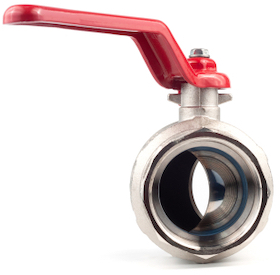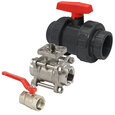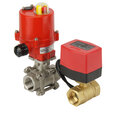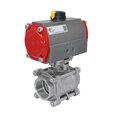Maintaining And Extending The Lifespan Of Your Ball Valves

Figure 1: Ball valve
Proper ball valve maintenance ensures the longevity and efficient operation of the valve. Ball valves are an integral component of various industrial systems, and their routine maintenance and quality checks help identify and address potential issues early, minimizing the risk of failures, costly repairs, and downtime.
Signs that a ball valve needs maintenance include:
- Leaks
- Difficulty turning the ball valve handle
- Unusual noises or vibrations
- Corrosion or other visible signs of damage
This article explores the importance of ball valve maintenance and a comprehensive maintenance program for ball valves.
View our online selection of ball valves!
Ball valve maintenance steps
Ball valve maintenance involves a systematic approach, including regular inspections, cleaning, lubrication, and testing to prevent problems before they occur.
- Regular cleanings: It is important to keep ball valves clean to extend their lifespan. It is recommended to clean them at least once a year, or more frequently if the environment is particularly filled with dust or dirt. Use a soft towel to wipe off oil, dust, or dirt from the casing. Use a wire brush to clear any buildup on the valve stem or other components. Use cleaning agents compatible with the valve materials, such as alcohol- or water-based cleaners for non-metal parts and compressed air or gas-based cleaners for metal components.
- Valve lubrication: Ball valve lubrication is essential to prevent abrasion and ensure smooth operation of the valve parts. Select a lubricant that is suitable for the valve materials and system media, such as water-insoluble, synthetic, or oil-based lubricants. However, it is crucial to avoid solid- or clay-based lubricants as they can accumulate inside the valve cavity.
-
Routine inspections: Check for regular wear and tear by checking the valve's seats, seals, and stem for any signs of corrosion, leaks, or damage. Increase the frequency of inspections for high-pressure and high-cycle applications. Examine the following parameters:
- Tightness of bolts, nuts, and other hardware. Loose bolts and nuts can cause the valve to shift or fail, resulting in equipment damage.
- Corrosion or mineral buildup
- Leaks
- Correct operation of ball valves during opening and closure
- Accurate position indication (including static valves)
- Adequate ventilation and air filtration in the area
- Replace the worn-out components as needed. Read our article on ball valve troubleshooting for more details.
- Scheduled plant shutdowns: Routine shutdowns are ideal for ball valve inspections. The process involves removing the valves from the piping system, disassembling them, cleaning the interiors, and replacing any worn or broken components. Pay careful attention to the seals or other rubber parts.
- Regular testing: Regular testing, like pressure testing (filling the valve body with a testing fluid and applying pressure for a specified length of time to check if it leaks) is essential to ensure that the ball valve is functioning correctly.
- Storage: Store the ball valve in a dry, well-ventilated area away from direct sunlight and extreme temperatures. Ideally, the temperature of the storage area should be between 0°C (32°F) and 49°C (120°F). If possible, store the valve in its original packaging or in a protective container to prevent any damage during transport or storage.
Factors that impact ball valve lifespan
Ball valve manufacturers typically provide an estimated product lifespan, usually around eight to ten years. While proper maintenance can help extend the lifespan of ball valves beyond this range, several other factors can influence their longevity.
- Media: Ball valves are typically used for controlling the on/off flow of liquids and gasses, such as water, oil, air, and chemicals. However, media with abrasive suspended particulates can lead to premature failure of valve seals, causing leaks or increased operating torque, ultimately leading to actuation failure. Using ball valves with abrasive media reduces their lifespan.
- Materials: Plastic ball valves are cost-effective but not suitable for high-temperature environments and have a shorter lifespan compared to metal valves. Metal valves are recommended for use with pressurized gasses for safety reasons. It is crucial to verify that the valve body and seal materials are compatible with the media flowing through the valve.
- Temperature and pressure ratings: When determining the suitability of a valve, it is essential to consider its pressure and temperature rating. The rating determines the proper materials, valve design, and seal materials that should be used. The rating, along with the cycle frequency, significantly affects the lifespan of the ball valve. If a ball valve is used in an application close to its pressure/temperature rating and cycled infrequently, it may last for years. However, the same valve in the same application may need frequent replacement if cycled often.
-
Actuation: Ball valves can be actuated manually, pneumatically, electrically, or hydraulically.
- Pneumatic actuators offer fast cycle times and high durability.
- Electric actuators are suitable for low cycle speeds and environments without access to compressed air
- Hydraulic actuators provide high torque output but are typically more expensive and may require additional components for proper functioning.
Benefits of ball valve maintenance
- Longevity: Routine maintenance and quality checks are necessary to identify any issues with the ball valve, which, if missed, could lead to equipment failures, damaged parts, or injuries to workers. Ball valves that require few to no repairs and last longer help save money, prevent downtime, and keep production on schedule.
- Security and safety: Ball valve maintenance experts can easily identify potential issues, lower the risk of emergency repairs, and prevent any hazardous leaks in the piping or processing system.
- Reduced need for shutdowns: Certain steps in ball valve maintenance can be performed while the valve is in operation, which allows the system to run uninterrupted, reducing the need for costly shutdowns.
- Cost savings: Regular inspection, maintenance, and replacement of ball valves on a projected schedule can reduce the need for unexpected repairs or replacements, thereby keeping more money in your pocket. Increased uptime means increased revenue, while fewer maintenance issues help save costs.
Read our articles on ball valve replacement and installation for more information on how to replace a ball valve if needed.
FAQs
Why is ball valve maintenance important?
Proper maintenance of ball valves is crucial to ensure their longevity, efficient operation, and safety. Neglecting routine maintenance can lead to equipment failure, downtime, and even injury to workers.
How often should I perform ball valve maintenance?
The frequency of maintenance depends on factors like the valve type, application, and operating conditions. Generally, ball valves should be inspected and maintained at least once a year, but more frequent maintenance may be necessary for valves in harsh environments or heavy use.









